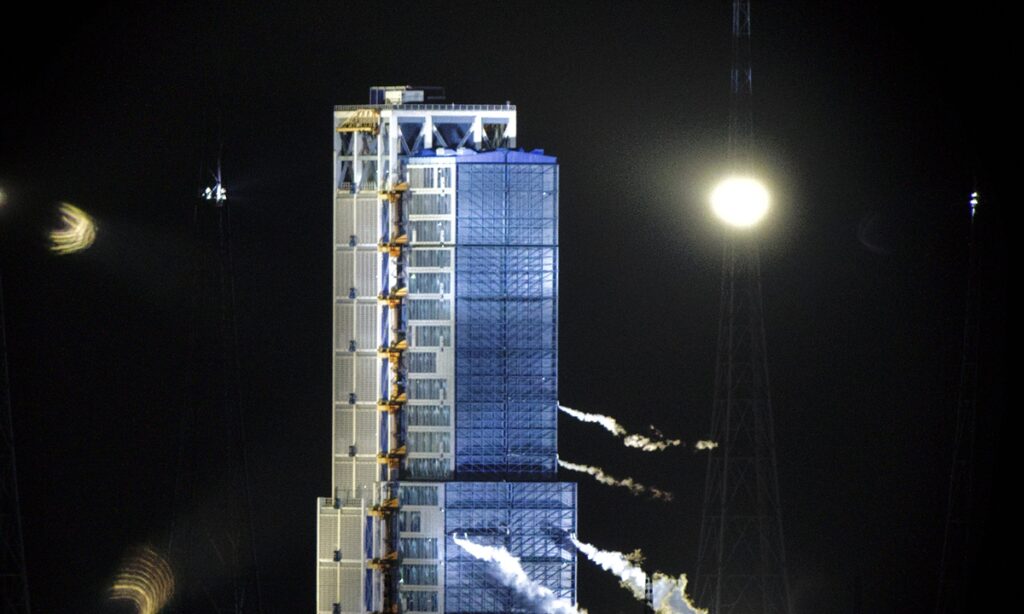China’s new-generation manned rocket, which is currently under development, will possess the capability to send taikonauts to the Moon by around 2030, Global Times has learned from China’s state-owned space giant China Aerospace Science and Technology Corporation (CASC).
A CASC spokesperson made the remarks to the media after the Long March 2D carrier rocket smoothly sent the remote sensing Yaogan-35 04 group of satellites on early Saturday morning, which saw the country’s Long March rocket series breaking its own record with 103 consecutive successful space launch missions.
According to the CASC spokesperson, the country’s super heavy-lift launch vehicle, which is also under development, will receive further strengthening to become capable of sending payloads of 50 tons to the Earth-Moon transfer orbit on completion, in order to support future lunar activity.
CASC is also working on a series of reusable space launch and transport systems, which will greatly boost the country’s space shuttle capability, lowering costs and empowering future development in this domain, the spokesperson said, per a statement the CASC provided to the Global Times.
Meanwhile, the US is busy preparing for the launch of the massive Space Launch System (SLS) rocket, which is set to take place on the morning of August 29 [US local time] from the US Kennedy Space Center for the Artemis I mission – the first test of NASA’s deep space exploration systems.
The Artemis I, according to the US space center, will be the first in a series of missions to demonstrate NASA’s ability to extend human existence to the Moon and beyond.
The US series’ first crewed flight, the Artemis III, will see boots on the lunar surface no earlier than 2026, more than half a century since NASA successfully sent humans to the moon in December 1972 in the Apollo 17 mission.
The US website space.com pointed out in an article on Friday that the 2026 mission is still “highly uncertain,” given that the mission is relatively far away, but NASA does have some early-stage planning for the later 2020s.
The timeline for these missions depends a great deal on how much funding the agency receives from US Congress, along with the technical progress of the Artemis program, the report said.
Even if NASA could pull off the ambitious plan, it would already be a two-year delay as the US space agency has abandoned its original goal of sending humans to the moon by 2024.
Drawing a comparison between the lunar manned landing plans of China and the US, Chinese space experts pointed out that the US’ practice of setting specific year deadlines is very rare in the industry, given the complex nature of deep space exploration, while China focuses more on technology readiness in a rather broad time frame, going forward steadily and surely.
China’s crewed moon landing is more in line with scientific principles, but NASA might grow more hostile against China in the space domain given the huge pressure it is facing to maintain its global leadership in moon exploration, Wang Ya’nan, chief editor of the Beijing-based Aerospace Knowledge magazine, told the Global Times on Sunday, when asked if there would be a new space race between space powers around 2030.
NASA chief Bill Nelson warned in July of a new “space race” with China, in a groundless accusation that China wants to “occupy the moon,” citing the lunar research base that China and Russia are co-building, which he is “very concerned about.”
It is very likely that in order to meet the goals of the Artemis mission, given its tight timeline, NASA will further open management access of the International Space Station (ISS) to commercial space players such as SpaceX after 2024, as Russia has warned of its intention to pull out from the ISS by that year, and shift focus and resources to its lunar plans, Wang noted.
Space observers also pointed out that as NASA is trying hard to relive its Apollo glories, China is working on innovative plans to carry out its own crewed moon landing missions.
Even without the new-generation manned rocket and super-heavy lift launch vehicle, leading Chinese rocket scientist Long Lehao revealed in August 2021, China could use two rocket launches to send two taikonauts to the moon by around 2030.
Long, an academician of the Chinese Academy of Engineering and chief designer of the Long March rockets, said during a speech that China was planning to use new variants of the Long March-5 launch vehicle – the strongest member of the Long March rocket family – to carry out the manned space launch missions.
Long referred to the new variant as Long March-5 DY, which stands for “dengyue,” meaning “lunar landing” in Chinese.
Two rockets carrying a lunar lander and a next-generation manned spaceship will be launched for the mission, and the two parts of the spacecraft will rendezvous and dock in near-lunar orbit, before executing the landing process. The two taikonauts are expected to work on the moon’s surface for some six hours, according to Long. However, there is no mention of a specific landing site.
The new manned spaceship will then take off from the moon and carry out another docking with the orbiting module before heading back to Earth.
(Global Times)




